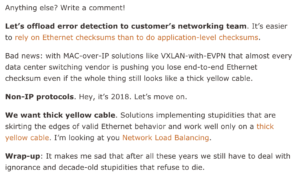Response: The Need For Stretched VLANs (@ioshints)
A recent post from Ivan Pepelnjak entitled Revisited: The Need For Stretched VLANs
made me smile rather bitterly as Ivan dug into the apparent continued desire for stretched layer 2 networks and the reasons
people give for the solution’s requirement and validity. I love a good bit of snark as much as the next nerd, so as you can imagine, I’m all over that post.

However, I confess I did wince slightly – in the way one might do when an old wound is poked with a sharp stick – as Ivan made a passing sarcastic reference to Microsoft’s amazing Network Load Balancing technology:
My mind was thrown back to the heady days of 2009 when I stumbled across another post from Mr Pepelnjak, this time entitled Turn a switch into a hub … the Microsoft Way
which bemoaned the unadulterated stupidity of Microsoft’s attempt to use layer 2 network flooding to accomplish clustering. I had discovered the nature of this behavior at a previous client and had my mind blown by the very stupid and non-standards-compliant way in which this had been implemented.
The reason my mind went to that post, however, is because if I recall correctly it’s Continue reading
Some Market Thoughts on the Broadcom SDKLT
Broadcom, to much fanfare, has announced a new open source API that can be used to program and manage their Tomahawk set of chips. As a general refresher, the Tomahawk chip series is the small buffer, moderate forwarding table size hardware network switching platform on which a wide array of 1RU (and some chassis) routers (often called switches, but this is just a bad habit of the networking world) used in large scale data centers. In fact, I cannot think of a single large scale data center operating today that does not somehow involve some version of the Tomahawk chip set.
What does this all mean? While I will probably end up running a number of posts on SDKLT over time, I want to start with just some general observations about the meaning of this move on the part of Broadcom for the overall network engineering world.
This is a strong validation of a bifurcation in the market between disaggregation and hyperconvergence in the networking world. Back when the CCDE was designed and developed, there was a strong sense among the folks working on the certification that design and operations were splitting. This trend is still ongoing, probably ultimately resulting Continue reading
Open Source Storage System Vitess Joins CNCF
 YouTube developed Vitess because it needed to scale massive amounts of traffic.
YouTube developed Vitess because it needed to scale massive amounts of traffic.
Broadcom Increases Qualcomm Takeover Bid to $121 Billion
 The semiconductor firm says this is its “best and final” offer.
The semiconductor firm says this is its “best and final” offer.
Response: Intent-based networking portends the future of infrastructure management
 Kurt Marko does a great job of explaining Intent Based Networking as an overall trend. I broadly agree with this perspective. Intent based networks are the new hotness among those needing a response to network complexity. We provide the 101 along with a reality check on what is available today. Intent-based networking portends the future […]
Kurt Marko does a great job of explaining Intent Based Networking as an overall trend. I broadly agree with this perspective. Intent based networks are the new hotness among those needing a response to network complexity. We provide the 101 along with a reality check on what is available today. Intent-based networking portends the future […]SDxCentral’s Top 10 Articles — January 2018
 Verizon boards the ONAP train; Huawei has yet another U.S. setback; and AWS and Salesforce want to say goodbye to Oracle.
Verizon boards the ONAP train; Huawei has yet another U.S. setback; and AWS and Salesforce want to say goodbye to Oracle.
Related Stories
Network Break 170: Broadcom Opens SDK; Cisco Launches Container Platform
The Network Break analyzes Broadcom open-sourcing its SDK, Cisco announces a container platform & other new products, Dell considers an IPO & more. Eyvonne Sharp is our guest. The post Network Break 170: Broadcom Opens SDK; Cisco Launches Container Platform appeared first on Packet Pushers.ONF Gears Up for Large-Scale CORD Demo at MWC
 The ONF admits work is still needed before CORD is ready for deployments.
The ONF admits work is still needed before CORD is ready for deployments.
Connecting the Internet of Things: 4 Steps
Follow these guidelines to streamline the deployment and management of IoT devices on the network.
Cisco Cloud Index: Data Center SDN to Skyrocket by 2021
 More than two-thirds of all data centers will fully or partially adopt SDN by 2021.
More than two-thirds of all data centers will fully or partially adopt SDN by 2021.
BiB 31: VMware NSX 6.4 Release Notes Round Up
Ethan Banks does a quick walk through of VMware's official release notes for NSX 6.4.
The post BiB 31: VMware NSX 6.4 Release Notes Round Up appeared first on Packet Pushers.
5 Intent-Based Networking Vendors
A look at some players in an emerging market that aims to radically transform how networks are built and managed.
Tier 1 carrier performance report: January, 2018
The post Tier 1 carrier performance report: January, 2018 appeared first on Noction.
Machine Learning and Network Traffic Management
A while ago Russ White (answering a reader question) mentioned some areas where we might find machine learning useful in networking:
If we are talking about the overlay, or traffic engineering, or even quality of service, I think we will see a rising trend towards using machine learning in network environments to help solve those problems. I am not convinced machine learning can solve these problems, in the sense of leaving humans out of the loop, but humans could set the parameters up, let the neural network learn the flows, and then let the machine adjust things over time. I tend to think this kind of work will be pretty narrow for a long time to come.
Guess what: as fancy as it sounds, we don’t need machine learning to solve those problems.
Read more ...Intentional Infrastructure
I gave a presentation at the recent Network Field Day 17 (on my 3rd day working for Juniper). My main goal for this presentation was just to get people excited about building stuff.
We tend to focus on vendor-provided solutions in this industry, and there’s a lot of good reasons for that, but it’s also good to stay sharp and be able to build your own solution to fill gaps where necessary. One reason I joined Juniper is that much of what we offer is built on a highly programmable foundation. So you get the best of both worlds - high-level products to solve the hard problems, but you still have the ability to insert your own custom tooling at various points in the stack.
In the above video, I outlined a simple Github-available demo for applying policies to a vSRX based on the existing services running in Kubernetes, and then verifying those policies are actually working by again using Kubernetes to determine what applications should be available.
My demo is designed to be self-sufficient, meaning you should be able to follow the README and get a working demo. Feel free to watch the above video first for context, then Continue reading
